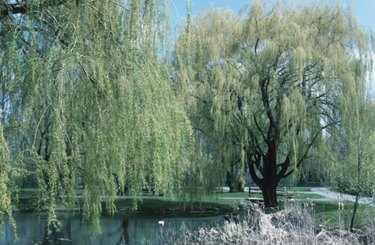
The willow grows in wet areas like riverbanks, lake sides and around streams and ponds. Its bendable branches have traditionally been used for basket weaving and making furniture. Some foraging animals depend on the high nutritional value of the willow's leaves. And willow's bark and leaves have yielded one of the most prescribed drugs in history. The leaves of the plant contain salicin, the main ingredient in aspirin. Long before there was aspirin, the healing properties of the willow were well-known to indigenous people.
White Willow
Video of the Day
White willow is the tree most commonly used for medicinal extraction. Native Americans boiled the leaves and chewed the bark for a variety of ailments. Tea and poultices made from willow leaves were used to relieve digestive problems, fevers, minor pains, toothaches, arthritis, gout, headaches and rashes.
Video of the Day
In ancient Greece, Hippocrates prescribed willow leaves to be chewed to ease the pain of childbirth.
Arroyo Willow
The Ohlone people of California had an extensive pharmacopeia before they were colonized by Europeans and exposed to Mexican-American communities as well. By the time their culture was studied, the native Ohlone had incorporated new plants in their medicine chest, but the willow remained an important remedy. Young leaves of the arroyo willow were boiled into tea to treat colds. The tribe's medicine shamans also treated fevers with a tea made from red willow bark.
Red Willow
The Ojibway people of Michigan's Upper Peninsula used red willow to cure indigestion and relieve pain. They chewed the leaves of red willows as an aid to quit smoking and chewing tobacco. The Ojibway also had many medicinal uses for the bark of the tree.
Peachleaf Willow
The Kiowa used the leaves of the peachleaf willow to make a tea for serious ailments. They rubbed the tea on the body to cure pneumonia and rheumatic aches and pains. A USDA study of the peachleaf willow states that tea made from willow leaves cures laryngitis and reduces joint and membrane inflammation. Rabbits, deer, moose and elk readily eat the tender, low hanging leaves and nibble the bark.
Riparian Forage
Willows grow where animals find convenient water holes, next to lakes, rivers, ponds and streams. This area is called the riparian zone, the transition between the aquatic zone and upland pasture. All species of willow leaves and twigs are forage for many animals who inhabit the riparian zone. Willow leaves provide year-round browsing for moose, elk and other wildlife; late summer and winter feed for cattle and deer.
Willow is an important forage because it maintains a high and steady protein content throughout all seasons, unlike upland grasses that lose protein value as the summer progresses. Some willow stands are regularly decimated by foragers in areas where alternative browsing vegetation is in short supply.